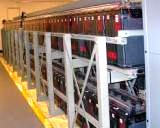SK type lead-acid storage battery support
 The storage battery provides constant operating current in the substation. The accumulator battery powers the devices for relay protection and automation of the equipment, signal circuits, provides power to the control circuits of the circuit breakers, communication equipment, as well as the emergency lighting system of the substation. The main task of the personnel who maintain the substation is to ensure reliable and uninterrupted operation of the battery.
The storage battery provides constant operating current in the substation. The accumulator battery powers the devices for relay protection and automation of the equipment, signal circuits, provides power to the control circuits of the circuit breakers, communication equipment, as well as the emergency lighting system of the substation. The main task of the personnel who maintain the substation is to ensure reliable and uninterrupted operation of the battery.
Consider the performance characteristics of an SK-type lead-acid storage battery.
A lead-acid battery usually consists of 110-120 cells. The average value of the voltage of one battery cell is 2.2 V. In total, all cells give a voltage in the range of 220-265 V.
The declared service life and optimal operation of this type of battery are guaranteed under the condition of constant charging. The battery is charged with special chargers.
Inspection of SK type lead storage battery
Substation maintenance personnel should check the battery daily. When checking the battery, personnel should pay attention to the following criteria:
-
integrity, cleanliness, lack of moisture in the boxes, the level of electrolyte in them;
-
the appearance of the plates;
-
the amount of sediment in the banks;
-
voltage on the control elements of the storage battery;
-
voltage on those elements on which, during the last inspection, a voltage drop below the set value was detected;
-
the condition of the contact connections between the battery cells;
-
serviceability of chargers, charging voltage and current;
-
internal air temperature;
-
serviceability of lighting, heating and ventilation systems.
In addition, at least once a month, the voltage and density of the electrolyte are measured on all cells of the battery.
The results of the inspection, measurements, including deviations from the normal operation of the battery, are recorded by the substation personnel in the relevant logs. If deviations from the normal operation of the battery are detected, senior personnel are notified and, if necessary, the necessary measures are taken to eliminate the malfunctions that have occurred.
Characteristics of SC lead acid storage battery
During battery operation, it is necessary to periodically add distilled water to the jars. As a rule, the electrolyte level in the jars should be 10-15 mm higher than the upper edge of the plates. The distilled water to be added should first be checked for chlorine and iron levels.
If the amount of sediment appearing at the bottom of the boxes increases rapidly, this indicates an increased float current.In this case, it is necessary to reduce the current, because an excessive increase in the float current leads to a significant reduction in battery life.
Conversely, the float current can be below the permissible values, which also negatively affects the battery. As a rule, a decrease in the density of the electrolyte in the banks indicates a decrease in the float current below the permissible values.
At least once a year, an additional check of the battery capacity should be carried out, in particular the voltage drop at high currents. The check is performed by giving a command to open and close the circuit breaker, which is characterized by a large driving current.
Precautions when servicing the battery
When servicing the battery, special attention should be paid to safety precautions. When making measurements, checks, addition of acid and distilled water, you must wear a special protective suit, apron, glasses, boots and gloves.
Before starting the battery check, it is necessary to turn on the ventilation for 30-40 minutes. If it is planned to carry out hot work in the room, then the ventilation of the room is turned on 1.5-2 hours before the start of work.
Acid, electrolyte, distilled water, vessels, reagents, etc. They must be stored in a room specially designated for this purpose.
Always keep a container of baking soda solution in the battery compartment. This solution is designed to neutralize acid that gets on the skin, mucous membranes or eyes.
See also on this topic: Lead-acid battery malfunctions and how to fix them
